2022 Annual Report
As we enter our fifth year (unmasked!), we thank the many staunch volunteers and over 100 generous individual donors who made URC’s accomplishments possible this past year. We also received funding from the Patagonia Seattle Flagship Store and the Peter Mason Family Charitable Trust again this year. And we just received news of a new grant for 2023 from the store team at Patagonia Seattle!
To all of you – donors, dedicated volunteers, keen-eyed band reporters, and friends – we thank you for your shared faith and contributions to our mission. Each one of you makes our tiny organization larger by your efforts and increases our collective knowledge of our region’s urban raptors. Your contributions of all kinds sustain us. This year you contributed to the following URC projects:
- Rodenticides in raptors study
- Long-term monitoring studies
- New falcon cam at 1201 Third Avenue
- Nest box
- URC banding program
- Optics for volunteers
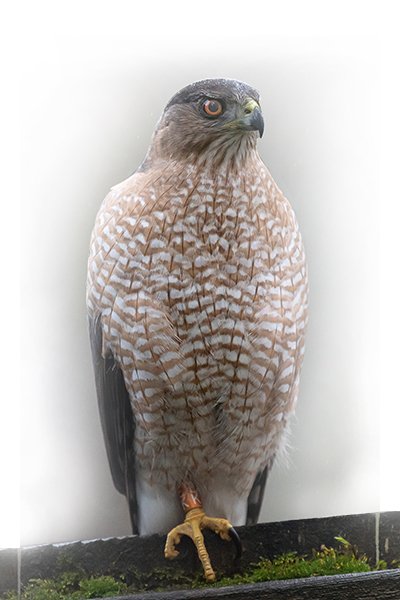
Adult female Cooper’s Hawk, now identified as orange right E-K. VID bands allow tracking of individuals without disrupting their normal activity. (Sam Hotaling)
Rodenticides in Raptors
Since 2018, URC has collaborated with PAWS Wildlife Center to test for the prevalence of anticoagulant rodenticides (blood-thinning rat poison) in dead raptors that were either brought to PAWS or died there. Although widespread contamination by anticoagulants in raptors has been reported elsewhere, it has never been systematically studied in Washington on a large scale. The results will provide a baseline of exposure rates in our region. We have just completed testing of 271 samples from dead eagles, hawks, falcons, and owls. Analysis is under way at last! Testing is expensive—up to $120 per sample. We could not have completed this important work without the funding from our grantors and individual donors.
Long-term Monitoring Studies: 2022 Results
Seattle Cooper’s Hawk Study. For the first time in 11 years of leading the study, we documented a downturn in numbers of nests and fledglings. Read our 2022 report.
Puget Sound Peregrine Project. We followed eight peregrine nests in Seattle and Tacoma in 2022. Three failed and the other five fledged 17 young. Read our 2022 report.
We made two noteworthy additions to the Seattle peregrine “infrastructure”.
New falcon cam at 1201 3rd Avenue (formerly WAMU for you old-timers). Wright Runstad, the long-time property managers, deemed it time to replace the original falcon cam. URC was honored to buy the new webcam to thank Wright Runstad for 28 years of peregrine hospitality. Their team is now working to get the new website/streaming service operational. The new falcon cam will be live any day.
New nest box on South Lake Union. When URC received permission to place a nest box at the new site at the AGC building, Martin Muller built and installed that nest box, and the peregrines did the rest. Nest boxes don’t just suddenly materialize, and we thank Martin for making it seem as though they do.
Seattle Merlin Project. In 2022, merlin breeding activity was documented at 24 locations in the greater Seattle area; 20 of these merlin pairs fledged young. We work closely with PAWS on the release of merlins in their care. One of these was a juvenile female merlin that could not be returned to her natal site, because her family had dispersed before she was ready for release. Instead, she was banded by URC (blue U-M) and released at Seattle’s Union Bay Natural Area (UBNA). She was seen hunting dragonflies, chasing birds, and sparring with crows and Cooper’s hawks at UBNA for at least two weeks post-release. This work would not be possible without the sighting reports we receive and our dedicated volunteers. SMP especially thanks Yuka Shibata.
URC’s Banding Program
We have research permits to use color visual ID (VID) bands on five species: Cooper’s hawks, peregrine falcons, merlins, and, in rehabilitated birds at PAWS, bald eagles and barred owls. VID bands greatly increase the prospects of identifying a banded bird in the field. They are not free: we purchase them at a cost of $10-20 each. In 2022, our supporters helped us buy over $6000 in color bands for all of our studies, which should last a few years. (Our VID-banded raptors also have aluminum federal ID bands, but their code is so small that it is rarely read in the field unless the bird is dead.)
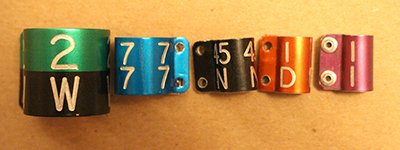
The color VID bands used in URC’s studies of the following five species (L-R): bald eagle, barred owl, peregrine falcon, female Cooper’s hawk, male Cooper’s hawk (Ed Deal)
Results from Band Sightings
We are indebted to the many of you who reported a band sighting. Your band reports inform us about bird movements, nesting, longevity and productivity. To report a band, contact either URC or the BBL. Another resource is the Washington Ornithological Society Research page, which lists regional studies and contact information.
Cooper’s hawks. In our study, females receive orange bands on the right leg and males receive purple bands on the left leg. In 2022, we banded 65 Coops. In 11 years, we have color-banded nearly 500 birds; almost half (46%) of those bands were seen again and reported.
Peregrine falcons. We put black bands with silver letters on urban peregrines in the region, continuing a study started by Bud Anderson in 1994. In 2022, we banded 11 peregrine fledglings. Since 1994, 187 peregrines have been banded in Seattle and 42 in Tacoma, with repeat sightings of 103 Seattle peregrines (55%) and 20 Tacoma peregrines (48%), ranging from Vancouver, BC, to Los Angeles. A peregrine female from our flagship 1201 Third Avenue nest, class of 2002, was found nesting in the central Oregon Cascades in 2011.
Merlins. URC banded 13 merlins for the Seattle Merlin Project this year.
PAWS Wildlife Center Banding Program. Our relationship with PAWS began in 2014 with the banding and release of a fledgling Cooper’s hawk. This relationship has strengthened over the years, and PAWS has become an excellent training ground for bird banding. Since 2018, we have put federal (aluminum) bands on all successfully rehabilitated raptors (hawks, owls, eagles, falcons), as well as color VID bands on the five species in our studies. The PAWS team of Patti Loesche and Jeff Brown banded 100 raptors in 2021 and 74 raptors in 2022.
We color-band two raptor species only when in rehab at PAWS: bald eagles and barred owls. Bald eagles receive green over black VID bands. Of 48 birds banded and released over three years, we have had reports (band sightings) on six (one dead, five live), a 12% rate of return. In a study begun in October, barred owls at PAWS receive blue VID bands. PAWS releases about 25 barred owls a year, mostly wayward juveniles. We hope to learn more about where and how far these species disperse after release.
Optics for Volunteers
Field volunteers often are able to offer their time and skills but could use better optics to aid their work. For this reason, URC established an optics loan program this year. We are very grateful to Paul Anderson, Pat Britain, and Denny Granstrand for their donations of good used spotting scopes and tripods for our volunteers.

Banded female bald eagle in 2022 at Oak Harbor, Washington, near where she was released by PAWS in 2020 (Marianne Perry)
Avian Influenza
In 2022 western Washington has had an ongoing and serious outbreak of Highly Pathogenic Avian Influenza (HPAI). The virus is carried by migratory waterfowl and spread to raptors and other birds. Locally, two bald eagles died this spring as soon as they fledged from their nest in Magnolia; they tested positive for HPAI. In October, the resident male peregrine at West Seattle Bridge died of HPAI. His mate has vanished and may be another AI victim.
HPAI is taking a vast toll on waterfowl and their predators during the fall migratory season. On 12/8/22 the Washington Department of Fish and Wildlife issued this Statement on Avian Influenza Outbreak Among Waterfowl around Skagit Bay.
The advisory includes this advice:
“Avoid all contact with sick and dead birds. DO NOT attempt to move sick birds to a veterinarian or rehabilitation center, or to your home, as this can spread the disease. If a dead bird must be moved, it is best to wear disposable gloves while handling it and to double bag and dispose of the carcass in the garbage where pets and scavengers can’t reach it.”
The Story of Peregrine Falcon 88-AK
Over the years we have invested considerable time and money in our peregrine banding program. Seattle peregrines have been reported from Vancouver, BC, to Los Angeles, but most peregrines banded as fledglings are seldom seen again. Only rarely do band reports bring us particular joy, when they help piece together a peregrine’s story from multiple sightings over time.
In 2017, the I-90 East Channel Bridge nest east of Seattle produced four young. Two big females fledged to the busy boat launch parking lot below. After hours of protecting them from cars and dogs as they wandered around the parking lot, it was apparent that they could not fly. They went to PAWS Wildlife Center and were banded and released 12 days later, in early July. One, 88-AK, had been seen several times since: in August 2017 in Skagit County, Washington, and later in January 2018, at Burnaby Lake, British Columbia.
We recently learned that 88-AK was nesting this year on the Alex Fraser Bridge in suburban Vancouver, BC. She is known to have nested from 2020 to 2022, fledging nine young. Given her age, she may have also nested in 2019. One of her fledglings from this year was grounded, rehabbed, banded (blue B-A), and released. Perhaps someday we will have news of 88-AK’s next generation.
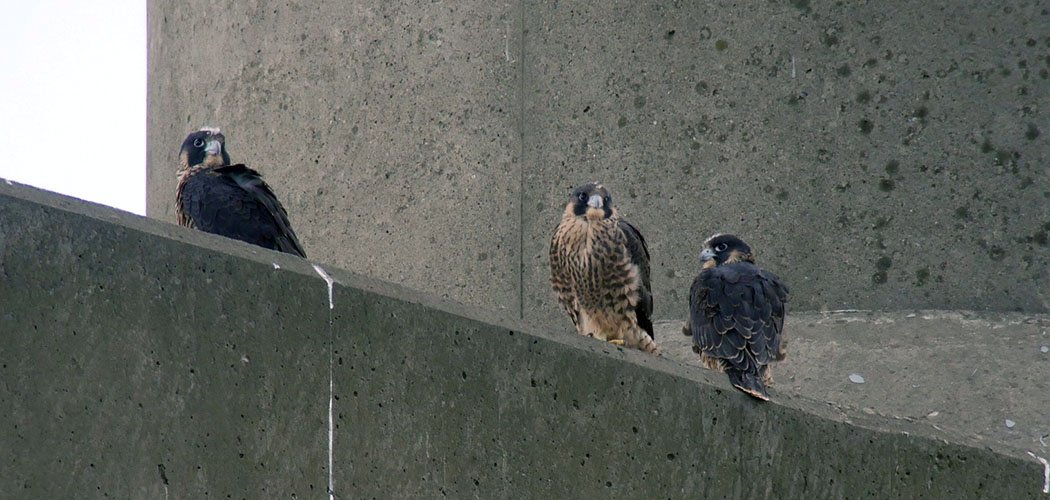
88-AK’s three offspring in 2021 at Alex Fraser Bridge, BC (Gordon Propp)
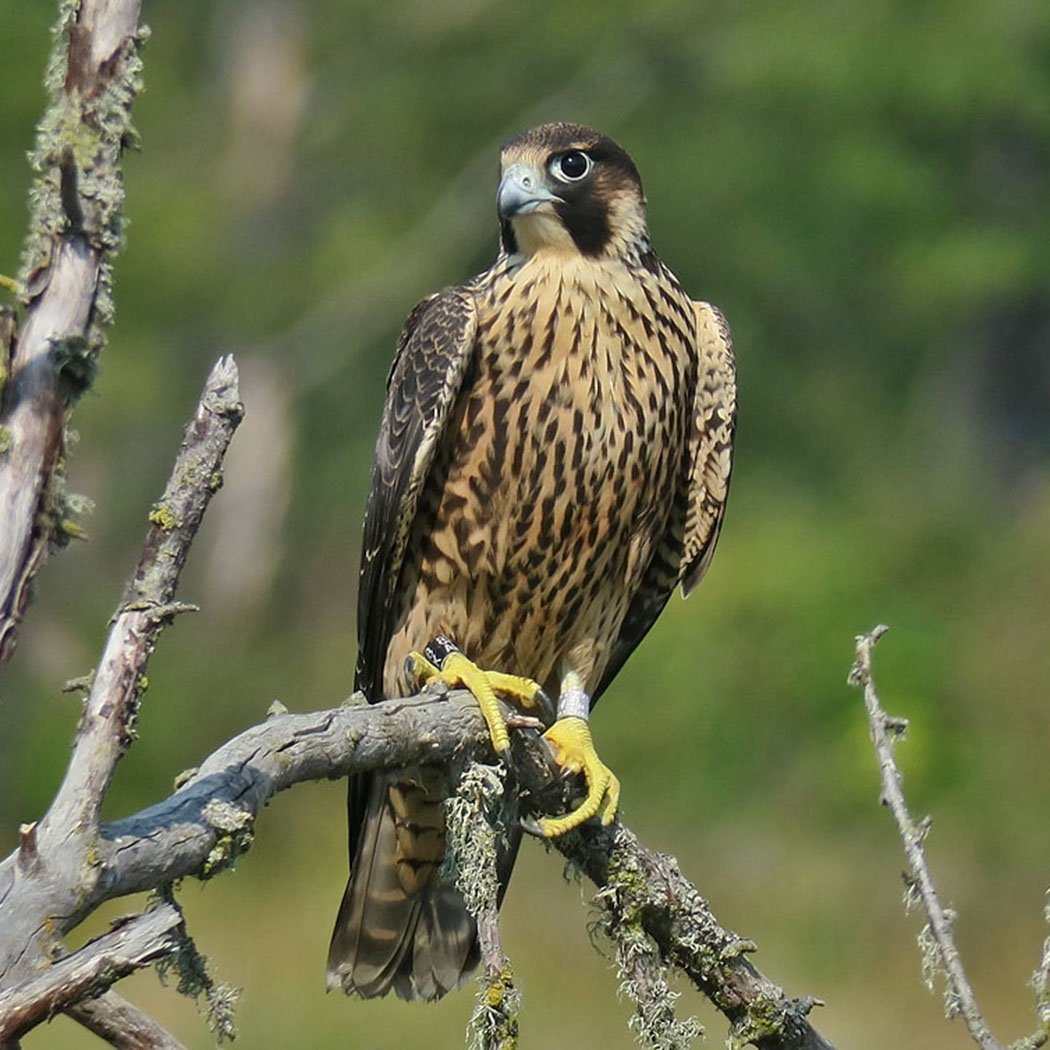
Juvenile female peregrine 88-AK at Wylie Slough, Skagit County, August 2017 (Mike Hamilton)
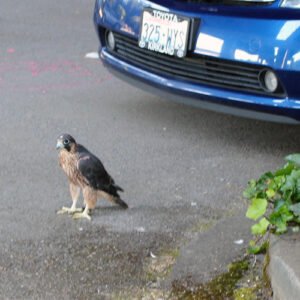
88-AK on fledging day, July 2017 (Ed Deal)
Volunteer Profile: Roger Orness
Roger has volunteered with Bud Anderson’s Falcon Research Group since the 1990s and has been an URC mainstay in more recent years. Among his contributions, he has helped to band fall migrants in Washington at Diamond Head, Chelan Ridge, and Entiat Ridge; assisted with urban peregrine surveys and nest monitoring in Seattle and Tacoma (and is almost the sole observer of the Tacoma peregrines); and been a route leader on the Skagit Raptor Census for 24 years. Roger has extensively surveyed southwestern Washington for the rare white-tailed kite and scoured the Central Cascades for cliff-nesting peregrines. This year, he followed the nesting season at Olallie State Park, where peregrines last nested in 2012. His stamina for long hours has resulted in observations that casual observers would never see, and his field notes set the standard that we all aspire toward. Chris Anderson, district wildlife biologist at WDFW and long-time raptor steward, wrote:
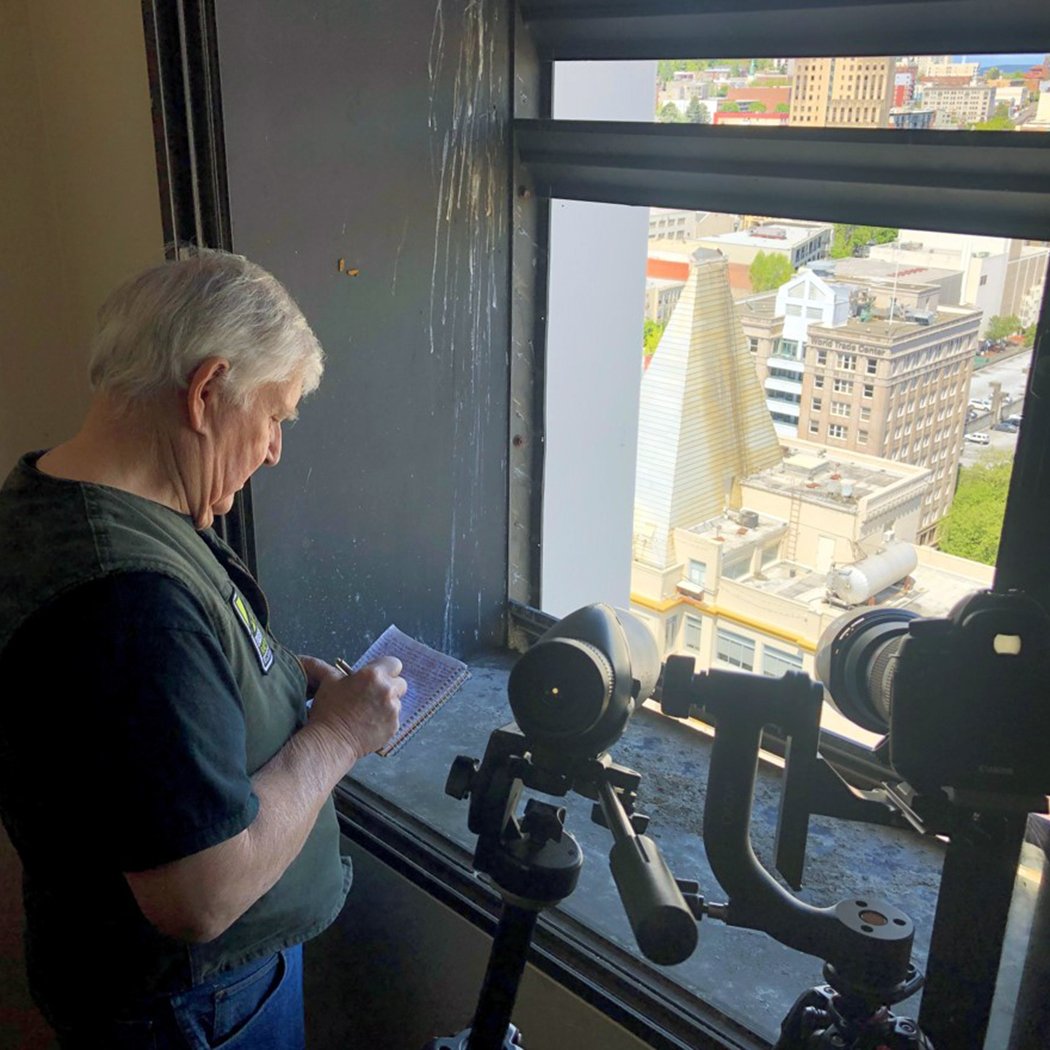
“The legend”: Roger monitoring the downtown Tacoma peregrine nest (Fergus Hyke)
“I first met Roger in 2012 [at Olallie]. This year, while monitoring this same nest site, Roger demonstrated his continued infectious enjoyment of falcon watching and sharing good stories. Roger is a trusted ambassador for wildlife and an asset to area conservation and management efforts. Thanks for being you, Roger! Area wildlife benefit from your care.”
URC Outreach
- The Seattle Times reported a fine story on the work of URC volunteers with urban raptors (May 2022)
- Ed Deal gave three online lectures on the Cooper’s Hawk Project in 2022. Two in-person talks in Washington are scheduled so far in 2023: at Rainier Audubon, Auburn (January 16) and Kittitas Audubon, Ellensburg (April 20).
- Pat Britain and Patti Loesche represented URC at the Expedia Farmer’s Market, where they were buzzed by an osprey carrying a fish. Urban raptors! (September 2022)
- Ed and Patti gave a talk on urban raptors for the Washington State Department of Transportation (December 2022)
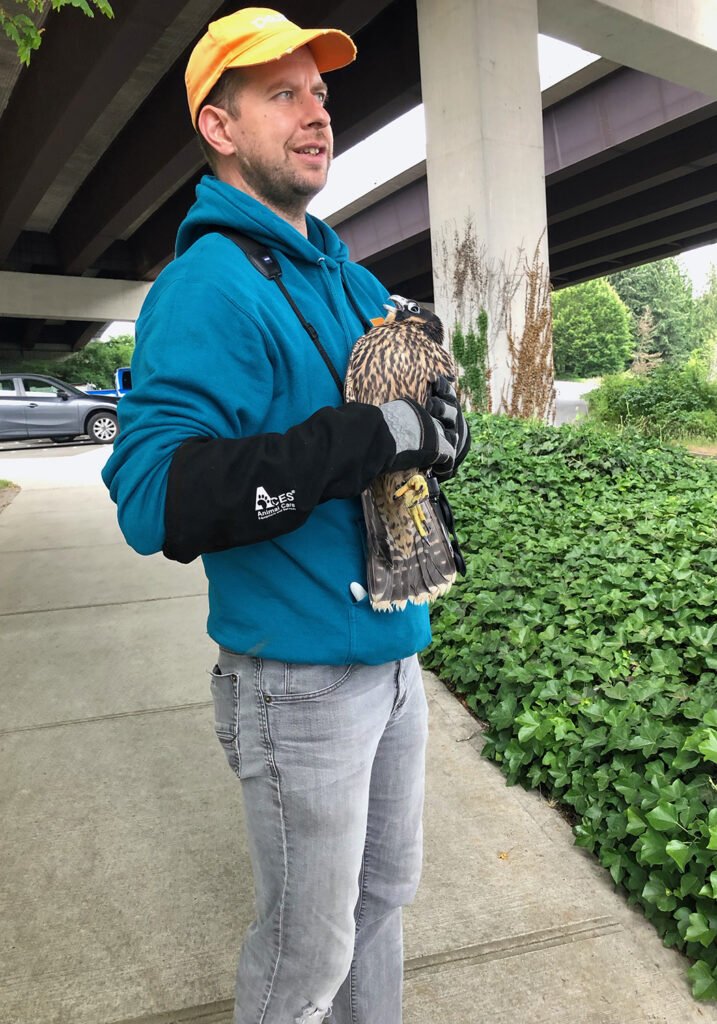
Jeff Brown releases a fledgling peregrine (Jenn Kovach)
Farewell to Jeff Brown
URC has long benefited enormously from PAWS Wildlife Center’s support of our efforts on behalf of urban raptors. We are particularly indebted to PAWS Wildlife Naturalist Jeff Brown, who has worked with us since URC’s inception. Jeff has been central to the successful rescue, rehabilitation, and release of many, many peregrines, Cooper’s hawks, and merlins, due in no small part to the intelligence, creativity, clear thinking, and seeming unflappability that he brought to each situation. Jeff earned a banding subpermit with master bander Ed Deal, and with Patti Loesche he has banded almost 200 raptors in rehab at PAWs. In addition to Jeff’s rehab skills, as a data-driven biologist he has strongly enhanced URC’s raptor research, assisting with data conceptualization and management on our rodenticide in raptors study, banding data, and post-release statistics. Jeff’s next career chapter is as a biologist with the National Park Service in California. He leaves big shoes to fill. Happy trails, Jeff.
URC Board
The URC Board for 2022 began with Patti Loesche (president), Ed Deal (vice president and treasurer), Martin Muller (secretary), with Robyn Ricks on the advisory board. In July, Martin left the board and Pat Britain joined us as secretary. And in October, co-founder Robyn Ricks joined our board at last! Here is your Urban Raptor Conservancy board for 2023:
Patti Loesche, President
Ed Deal, Vice President and Treasurer
Pat Britain, Secretary
Robyn Ricks, Creative Advisor
In 2023, we will continue our current research and banding programs, while also providing additional training for our volunteers and working to deepen our community engagement. We rely on your funding to make our work possible. Please consider helping us by making a one-time or monthly donation.
Thank you, and Happy New Year!